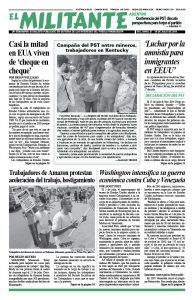A brief, but acrimonious, exchange about busing for school desegregation between Kamala Harris and Joe Biden at the June 27 Democratic Party debate in Miami received lots of news coverage but had little substance.
Neither Harris nor Biden are interested in telling the real history of the fight to desegregate the schools — a key part of the fight to end Jim Crow segregation in the 1960s, ’70s and beyond. The Democratic Party was the main actor in trying to block desegregation of schools both in the South and the North.
Harris accused Biden of opposing mandatory federally imposed busing for school desegregation in the 1970s. And that’s true, as did the whole Democratic Party leadership. Really what Harris was after was race-baiting Biden. “I do not believe you are a racist,” she said, which was a setup to accuse him of exactly that. Harris implied that she defends government-ordered busing to desegregate schools.
But she doesn’t. Her position is almost identical to Biden’s. She told reporters July 4 that she does not support federally mandated busing. Like Biden, she backs “voluntary” busing, when agreed to by local governments.
But desegregating U.S. schools was a major social struggle. It began in the South. In 1954 the U.S. Supreme Court ruled that “separate but equal” was “inherently unequal,” outlawing racially segregated schools.
Black youth were already often being bused — right past all-Caucasian schools to all-Black schools. Black schools received two-thirds or less of the funds that Caucasian schools received. Classes were overcrowded, while there were empty seats in the better-supplied Caucasian ones.
But the court ruling remained a piece of paper until Black workers and their supporters initiated what became the massive protest movement that tore down Jim Crow segregation.
Under the pressure of the mass protests, the U.S. government was forced to send in federal troops to ensure schools were desegregated, including by busing. Without this the racist forces like the Ku Klux Klan and similar groups — alongside Democratic Party-led governments — would have ensured the schools would never have been desegregated.
Schools in city after city, from grade schools to the University of Alabama, were opened to Black youth and racist prejudice was hit with a body blow.
Perhaps the biggest fight — and some of the most violent resistance by racist forces — took place in the North after federal Judge Arthur Garrity ordered widespread busing after ruling in the summer of 1974 that the Boston school board had deliberately segregated the schools.
The Democratic Party machine ran the Boston government. They whipped up racist forces, claiming they were defending “local control” of schools.
Racist organizers were invited to meet in City Hall to mobilize a fight, including a boycott of the schools. Racist mobs attacked buses carrying Black students to their schools. Supporters of busing organized a picnic at a beach, off-limits to Blacks for years. They were attacked by racists as cops looked the other way.
The Socialist Workers Party backed the Black rights movement in both the South and the North. SWP presidential candidate Farrell Dobbs helped organize the first station wagon driven to Montgomery, Alabama, to help strengthen the 1955-56 boycott of segregated public transportation there.
The SWP was centrally involved in defending busing — including winning Caucasian workers to support the fight — during what became known as the Battle of Boston. The party helped organize two national pro-busing marches of more than 10,000 each in Boston in December 1974 and May 1975.
The movement broke the back of the anti-busing violence and desegregation won out.
In the absence of a continuing fight, and ongoing Democratic Party opposition to busing, as exemplified by both Biden and Harris, many schools face growing imbalance. Today, half the population of Boston is Caucasian, but only 14 percent of public school students.
But it would take a bloody counterrevolution to reverse the gains of the Black-led working-class movement that smashed Jim Crow segregation.

